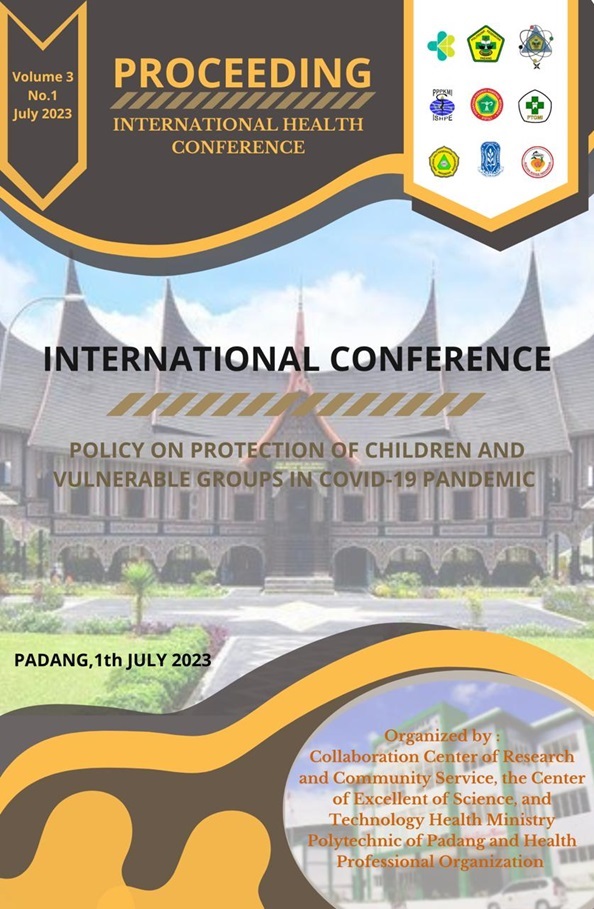Protein Content and Acceptability of Nutrient Dense Noodles Based on Local Food as an Alternative to Emergency Food
Abstract
Noodles are foods that are accepted by all levels of society, including adults and children. There are various types of noodles, one of which is wet noodles. Wet noodles are high in carbohydrates, but low in protein. Noodles that are usually sold in the market require 8.4 grams of additional protein to comply with SNI, which is a minimum of 9.0 grams of protein in 100 grams of wet noodles. So it is necessary to add dried rebon shrimp flour as a protein source. The purpose of the study was to determine the protein contentand acceptability of wet noodles substituted with dried rebon shrimp flour. The type of research is experimental research in the field of food technology with a completely randomized design (CRD) one control, three treatments, two repetitions. Test of protein content in the Baristand Padang laboratory and acceptance test at SDN 10 Surau Gadang. The study was conducted from March 2020 to April 2021. The best treatment was obtainedby organoleptic testing. The results of the organoleptic test obtained the best treatment with a ratio of 75:25 grams, 8.1% protein content and as much as 80% of the target can spend the product. It is recommended to do a acceptability test after a laboratory test, as well as conduct a food safety test.
Downloads
References
Standardisasi D, Pangan P, Bidang D, Keamanan P, Berbahaya Dan, Pengawas B, Et Al. (20130. Pedoman Pangan Jajanan Anak Sekolah Untuk Pencapaian Gizi Seimbang. Jakarta: Badan Pom RI.
Riset Kesehatan Dasar. Laporan_Nasional_Rkd2018_Final.Pdf [Internet]. Badan Penelitian Dan Pengembangan Kesehatan. 2018. P. 221–2. Available From: Http://Labdata.Litbang.Kemkes.Go.Id/Images/Download/Laporan/Rkd/2018/Lapora n_Nasional_Rkd2018_Final.Pdf
Ratnasari DK. Gambaran Kebiasaan Konsumsi Mie Instan Pada Anak Usia 7 – 12 Tahun Studi Di Sekolah Dasar Kanisius Tlogosari Kulon Semarang. Universitas Diponegoro Semarang; 2012.
Iklima N. Gambaran Pemilihan Makanan Jajanan Pada Anak Usia Sekolah Dasar. J Keperawatan BSI. 2017;5.
Qonitatul’An F. Penilaian Orang Tua Dan Upaya Pembentukan Konsep Diri Anak Terhadap Makanan Jajanan Beresiko Gizi Lebih. Repos Univ Jember. 2018;
Kementrian Kesehatan Republik Indonesia. (2019). Angka Kecukupan Gizi. Menteri Kesehat Republik Indones Peratur Menteri Kesehat Republik Indones [Internet]. 2019;Nomor 65(879):2004–6. Available From: File:///C:/Users/KHAIRU~1/Appdata/Local/Temp/Permenkes Nomor 28 Tahun 2019.Pdf
Maryam S, Damiati, Wiratini Inm. (2017). Peningkatan Pengetahuan Dan Keterampilan Ibu- Ibu Pkk Kampung Bugis Dalam Pengolahan Mie Sehat. Int J Community Serv Learn.
Winarno F. (2016). Mi Instan : Mitos, Fakta Dan Potensi. Jakarta: Gramedia Pustaka Utama;
Kementerian Pertanian. (2019). Direktori Perkembangan Konsumsi Pangan. Badan Ketahan Pangan. Jakarta
Mahmud M Dkk. (2018). Tabel Komposisi Pangan Indonesia. Jakarta
Nasional BS. (2015). Standar Mutu Mi Basah.
Radianti R. (2019). Pengaruh Suplementasi Tepung Udang Rebon (Mysis Sp.) Terhadap Mutu Organoleptik, Kadar Fe, Dan Daya Terima Risoles Sebagai Makanan Jajanan Pada Remaja. Poltekkes Kemenkes Padang
Statistik BP. (2017). Statistik Provinsi Sumatera Barat Dan Indonesia Dalam Angka 2017. 2020.
Harahap MS Dkk. (2018). Pengaruh Penambahan Konsentrasi Enzim Papain Yang Berbeda Terhadap Karakteristik Hidrolisat Protein Udang Rebon. J Online Mhs Bid Perikan Dan Ilmu Kelaut
Helfina M. Pengaruh Substitusi Tepung Ikan Teri (Stolephorus Spp) Terhadap Mutu Organoleptik Dan Kadar Protein Dalam Pembuatan Mie Basah. Poltekkes Kemenkes Padang; 2014.
Candra Dan HR. Peningkatan Kandungan Protein Mi Basah Dengan Penambahan Daging Ikan Belut (Monopterus Albus Zuieuw). J Tek Lingkung. 2018;4.
Gobel RV Dkk. Formulasi Cookies Udang Rebon. J Ilm Perikan Dan Kelaut. 2016;4.
Khodijah N Dkk. (2020). Pengaruh Variasi Pencampuran Tepung Udang Rebon (Acetes Erythraeus) Pada Stick Ditinjau Dari Sifat Fisik, Sifat Organoleptik, Dan Kadar Protein. Repos Poltekkes Kemenkes Yogyakarta
Sundari D Dkk. (2015). Pengaruh Proses Pemasakan Terhadap Komposisi Zat Gizi Bahan Pangan Sumber Protein. Media Litbangkes










